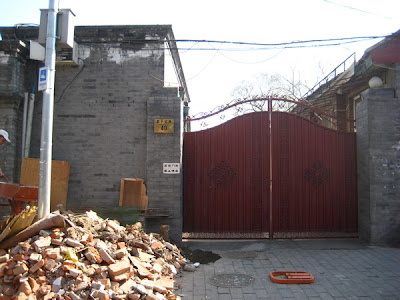The American accent is high in demand in China, where it's considered "standard" English. In China, there is "Standard Mandarin"-- a pure, unaccented version of good ol' putonghua, the language Chairman Mao enforced to become the language of the nation, simply because it was what was spoken in the capital. I keep reminding my students that there's really no such thing as "Standard English," but years of watching Friends and Prison Break has given many Chinese the impression that if one wants to speak English, they should speak it as Monica and Rachel do when they're bickering in their fabulous Manhattan flat.
Being from California-- where most American TV shows and films are from-- and having a Western American accent has blessed me in the TESL department, since I was born with the "standard" accent. So it was only natural that my friend and colleague, Zhang Kun, asked me to co-teach a Pronunciation Class with him.
 |
| My buddy Zhang Kun and me |
Teaching Pronunciation is a really tricky thing. Imagine trying to tell someone how exactly to manipulate their mouth to make them pronounce "usually," when what keeps coming out is "urally," or to say "think" instead of "sink." Or explaining why your sentences drift up and sink down at certain parts. It ain't easy. Fortunately, Zhang Kun had undergone the long arduous task of trying to perfect the American English accent, though what comes out now is more of a charming marriage of British and Chinese English.
After a few hard weeks of class, Kun offered to give Jason and me a proper introduction to Old Beijing snacks, since we still didn't really know exactly what Beijing cuisine was. He took us to a place that is just about as old school as you can get. You first go to a ticket window, where you buy 50 RMB worth of paper tickets. Then, you go from window to window, exchanging tickets for snacks.
 |
| Snack offerings and illustrated menus |
Beijing snacks are-- at best-- interesting. It's mostly marked by fatty meats, sesame flavoring, and a lot of heavy, oil-laden fried things. Neither Jason nor I were big fans, but we were grateful for the experience.
It's not an authentic Chinese meal until you eat some unusual animal part. This is a plate of flash-boiled tripe. Despite the aforementioned piping-hot bowl of thick, oily sesame soup waiting for me, the tripe comes with a bowl of sesame paste sauce meant for dipping. I actually quite like tripe, but this wasn't my favorite incarnation of it.
These little sandwiches were what I had my hope for a good meal riding on. Sadly, they didn't deliver. I've had some excellent versions of the sandwich (called bing in Mandarin), where the meat is juicy, flavorful, and dripping with yummy fats that are soaked in by the sesame seeded bun. What we found were two sad, cold, dry sandwiches lacking in any flavor except salt.
After our meal (on which Jason later commented that he'd never eaten at a meal where he didn't like a single thing on the menu), we three decided to take advantage of the rare beautiful Spring weather and take a walk through Beijing's historic area. We passed the back end of the Forbidden City, and Zhang Kun took us to one of the oldest standing Catholic cathedrals in Beijing.
While we weren't thrilled about the grub, it was a good day.
While we weren't thrilled about the grub, it was a good day.



























